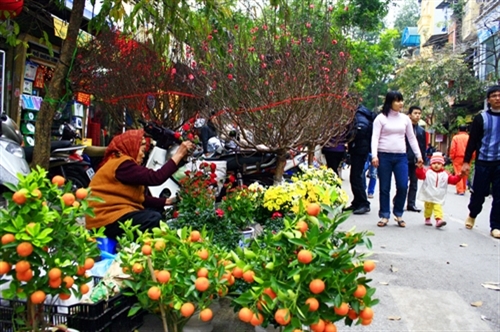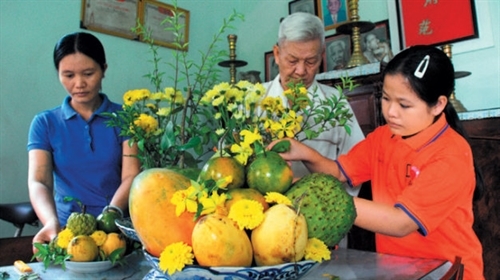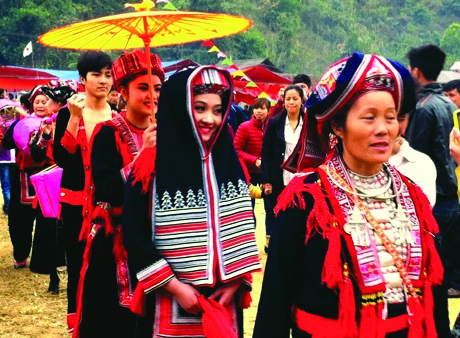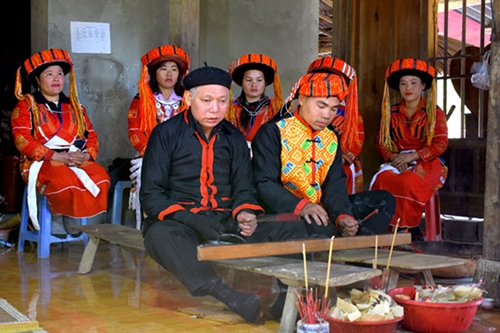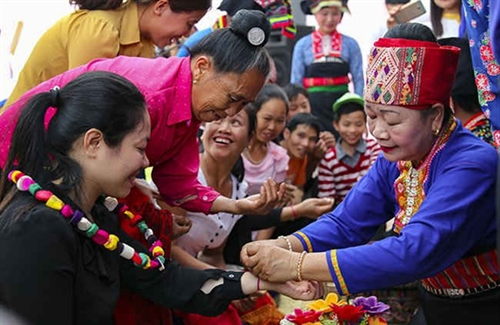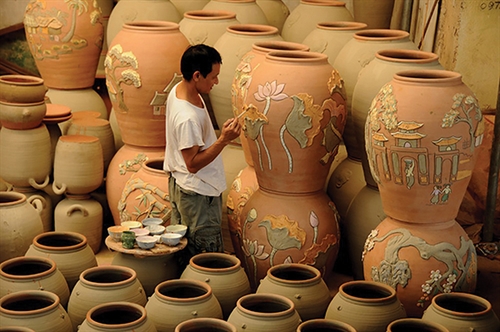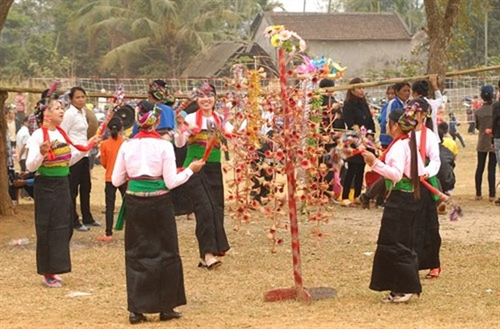Spring is considered the season of festivals for ethnic minority people. Each ethnic group has its own festivals characterizing its customs, beliefs and farming practice. Vietnam Law and Legal Forum introduces some typical spring festivals across the country.
New rice festival of Central Highlands people
The spring or new rice festival is held by E De, Gia Rai, Ba Na, Xo Dang and M’Nong ethnic groups in the Central Highlands after harvest time to welcome a new year. Dedicated to the god of rice, the festival is held in early lunar new year to wish for favorable weather for crops. It also seeks support from gods for good health and prosperity for all villagers. Ritual offerings include newly harvested fragrant rice, ruou can (rice wine drunk from a jar through stalks), a cockerel, a hog and meat of wild animals. During the festival, a rite dedicated to the god of water is conducted to ask for clean and clear water, implying good health for villagers. On festive days, villagers drink ruou can and dance to the sounds of gongs.
Festival celebrates new homes of the Lo Lo
New home celebration is the merriest spring festival of the Lo Lo in the northern mountainous provinces of Ha Giang and Cao Bang. Under the group’s custom, a newly married couple must build a house on their own and celebrate their home in early lunar new year.
Celebration of a new home is a feast to which all villagers are invited. Attending this party, men bring wine and meat while women take sticky rice and cakes with them. A sorcerer is invited to conduct an offering rite dedicated to deities, praying for their support for the home owners to have good health and luck. After this ceremony, the host brings a big gourd for villagers to break it up, then cooks and offers it to all people. After the party, craftsmen play clarinets and flutes while young men and women sing throughout the night.
H’Mong outdoor playing festivity
Gau tao, which means outdoor play in H’Mong language, is a traditional new year festival of the H’Mong. Annually, a H’Mong village will meet and select a family to host the festival, which is usually held after the 2nd day of the first lunar month and lasts between one and three days.
On the opening day, the host prepares offerings for a ceremony to show gratitude to the heaven and earth for giving villagers health and children and pray for peace and prosperity for the village. The formality to open the festival is a pan-pipe dance followed by a singing performance led by some old men and the festival owner who is usually a prestigious villager. After that, different activities take place on a big hill, including crossbow shooting, top playing, danh yen (a game similar to badminton with the shuttlecock made of bamboo stuck with some feathers), nem pao (transferring a colorful cloth ball between teams) and gau plenh (love song) singing.
Fire jumping by the Pa Then
Nhay lua (fire jumping), a harvesting festival, is an original cultural activity of the Pa Then. Held right after Tet (lunar new year festival), the festivity, which reflects the Pa Then’s strength and wish to conquer nature, aims to win support from the god of fire for favorable weather, bumper crops and happiness. The god of fire is also believed by the Pa Then to expel evil spirits and save people from misery, bringing them peace and prosperity. The festival starts with lighting a fire for a deity worshiping rite conducted by a sorcerer who, surrounded by young men, sits on a bench, beating two iron objects to create repeated sounds. The young men then sit on the bench in turn, starting to get into a trance. Bending down and shaking their bodies, they start jumping and within moments, turning strong and jumping into the fire without feeling hot. Some even lay down in the fire before jumping out. Pa Then people believe the duration a man can jump in a fire depends on his strength bestowed by deities, which keeps him from being burned.
Ba Be spring festival
The festival is held annually on the 10th of the first lunar month in Ba Be district of the northern mountainous province of Bac Kan. Opening the event is an offering made by 16 communes. Sixteen offering trays, each of which contains sticky rice, a chicken, a bunch of bananas, sweet rice cakes and a bottle of maize wine, are presented by country girls to the gods of mountain, river and lake in the wish for a peaceful year of flourishing growth. Followed the offering rite are traditional games such as dugout racing, nem con (throwing a cloth ball through a ring), traditional wrestling, archery, singing and dancing, the most exciting of which is boat racing on Ba Be lake.
H’Tend, new year celebration of the H’re
H’Tend, the festival of the H’re, who lives mostly in central Vietnam, takes place in the second or third lunar month. Before H’Tend, people prepare food, clean their homes and villages, set up cay neu (new year tree) and prepare musical instruments and clothing. On the first day of H’Tend, H’re people conduct a rite to clean their homes, expel evil spirits and receive fortune and happiness. This rite is followed by an offering ceremony to deities and ancestors who are believed to join family members celebrating the new year and protect them. After these two rites, villagers make sticky rice cakes and kill pigs and chickens as offerings for a buffalo worshiping ceremony held the next day. This ceremony is held at dawn right at the buffalo stall to pray for good health for the cattle. After that, people have a party together, drinking ruou can, chatting, playing gongs, dancing and playing traditional games. On the last day of H’Tend festival, people clean homes to welcome guests. During H’Tend, people wish one another good health, success and prosperity.
Muong Bi people start a year with khai ha festival
Khai ha (going down the field) is a big festival of Muong Bi group in Hoa Binh northern mountainous province. Held annually right after Tet to review the old year and mark a new year, the festivity is a chance for Muong Bi people to show their respect for gods and pray for a year of peace and prosperity. According to Muong Bi custom, only after khai ha can people go down the field to prepare a new crop and go to the forest for hunting and picking up forest products. People attending this festival all bring along a rice ball. The festival consists of two main parts: the offering ceremony conducted at the village temple and festive activities. An original trait of khai ha is the formality to repair Lo canal, the one irrigating the whole region. Each family sends a member to dredge and clean up the canal. After that, people have a meal together, eating food offerings shared to them and drinking ruou can. Festive activities open with the gong performance by Muong girls, followed by folk games such as crossbow shooting, tug of war, top playing, sac bua (gong playing) competition and responsive singing.
Xen Ban, Xen Muong, Thai ceremony dedicated to village founders
In the second lunar month, Thai people hold Xen Ban, Xen Muong, one of the group’s biggest festivals in memory of founders of Muong, the land of the Thai. Starting the ceremony is a procession of the offering tray from the village head’s home to the communal house. Leading the procession are the village head and other dignities, followed by young people carrying four gongs and a drum together with pan-pipes and flutes. Then come old villagers in colorful costumes, bringing bows and arrows and taking two buffaloes as the sacrifice. Finally are the village’s guards also in colorful costumes and red hats, carrying matchlocks, swords and spears on their shoulders. The procession is followed by the sacrifice ceremony conducted by a sorcerer. After that young people join dancing and singing contests, archery competition and play nem con. After the festival, Thai people have some taboos of receiving strangers, farming and going to forest for several days. Every house is closed with green tree branches hung outside.
Roong Pooc, biggest festival of the Giay
Annually on the day of the dragon of the first lunar month, the Giay in Sa Pa, Lao Cai northern province, opens Roong Pooc (going down the field), the festival dedicated to the Jade Emperor, fairies and deities, praying for their support for prosperity, peace and fine weather throughout the year. Giay people believe if they fail to celebrate Roong Pooc in a year, they will encounter numerous difficulties in that year, suffering misfortunes such as illness and natural disasters.
Roong Pooc starts with a sorcerer’s ritual offering. The offerings, which symbolize prosperity, include cloth, eggs, bamboo shoots, silver coins and 6 qua con (cloth ball) made by unmarried girls. Closing the ritual, the sorcerer gives the cloth balls for prestigious old villagers to throw them through the ring put on a high bamboo pole. Symbolizing the sun and moon, this ring has one side stuck with red paper and the other with yellow paper. When the ball is thrown through the ring, each family in the village burns incense on the altar set up for the offering rite to pray for good luck for their family and village. Villagers then play nem con, tug of war and hold a plowing competition for young men.
Thac Con, Kh’mer unique festivity
Thac Con, which means beating a gong in Kh’mer language, is also called coconut offering festival since the main offering of this ceremony is thousands of fresh coconuts. Held annually in the middle of the third lunar month in An Trach village, Soc Trang southern province, the festival was originated from a century-old legend which said that long time ago there appeared a gong-shaped hillock in the old land of An Trach. Every time a person stepped on this hillock, an echo resounded from the entrails of the earth. As time passed by, the sacred hillock disappeared, on the site of which the Kh’mer built a temple called Thac Con.
Offerings of this three-day festival are fruits and flowers which symbolize purity and sacredness, including coconuts, betel and areca, lotus, tuberose and marigold. The flowers are arranged in beautiful vases made from coconut shells. Each visitor to this festival often brings one or two pairs of coconuts as the offering. The event is the chance for Kh’mer people to pray for happiness and meet relatives and friends. On the festival’s closing day, An Trach women, old and young, take offered cereal seeds on the altar and some ash from the incense-burners in the temple and sow them in the fields in the hope that those seeds and ash will bring all people and families prosperity and happiness.- (VLLF)
